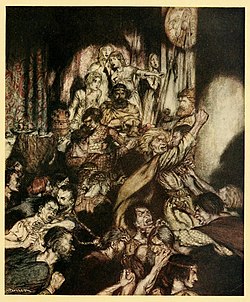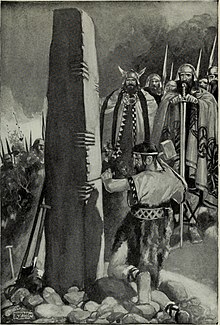Fianna

Fianna(/ˈfiːənə/FEE-ə-nə,Irish:[ˈfʲiən̪ˠə];singularFian;[1]Scottish Gaelic:Fèinne[ˈfeːɲə]) were small warrior-hunter bands inGaelic Irelandduring theIron Ageandearly Middle Ages.Afianwas made up of freeborn young males, often from theGaelic nobility of Ireland,"who had leftfosteragebut had not yet inherited the property needed to settle down as full landowning members of thetúath".For most of the year they lived in the wild, hunting,cattle raidingotherIrish clans,training, and fighting as mercenaries. Scholars believe thefianwas arite of passageinto manhood, and have linkedfiannawithsimilar young warrior bandsin other early European cultures.
They are featured in a body ofIrish legendsknown as the'Fianna Cycle' or 'Fenian Cycle',which focuses on the adventures and heroic deeds of thefianleaderFionn mac Cumhailland his band. In later tales, thefiannaare more often depicted as household troops of theHigh Kings.
TheFenian Brotherhoodof the 19th-century and theFianna Éireann,anIrish nationalistyouth organisation of the 20th century, are named after them.
Historicity
[edit]The historical institution of thefíanis known from references inearly medieval Irish law tracts.Afían(pluralfíanaorfianna) was a small band of roving hunter-warriors.[2]It was made up of landless young men of free birth, often youngaristocrats,[3]"who had leftfosteragebut had not yet inherited the property needed to settle down as full landowning members of thetúath".[4]A member of afíanwas called afénnid;the leader of afíanwas arígfénnid(literally "king-fénnid").[5]Thefíanway of life was calledfíanaigechtand involved living in the wild, hunting, raiding, martial and athletic training, and even training in poetry.[2]They also served as mercenaries.[2]Wild animals, particularly the wolf and the deer, seem to have beenfíanmascots.[2]Some sources associatefiannawith the outdoor cooking pits known asfulacht fiadh.[2]
Many of the first mentions offiannaare connected withScotiraids inBritain during the end of the Roman rule.[6]
Geoffrey Keating,in his 17th-centuryHistory of Ireland,says that during the winter thefiannawere quartered and fed by the nobility, during which time they would keep order on their behalf, but during the summer/autumn, fromBeltainetoSamhain,they were obliged to live by hunting for food and for pelts to sell.[7]Keating'sHistoryis more a compilation of traditions than a reliable history, but in this case scholars point to references in early Irish literature and the existence of a closed hunting season for deer and wild boar between Samhain and Beltaine in medievalScotlandas corroboration.[8]Hubert Thomas Knox(1908) likened thefiannato "bodies ofGallowglassessuch as appeared in the fifteenth and sixteenth centuries, but then under command of adventurers who were not inhabitants of the province, Free Companies who sold their services to any one who could raise their wages ".[9]
Joseph Nagy writes that thefíanseemingly "served a vital function in siphoning off undesirable elements [...] providing an outlet for rambunctious behaviour", and was arite of passagethat prepared young men for adult life.[2]Katharine Simms writes that "While most members eventually inherited land, married and settled down, some passed their lives as professional champions, employed by the rest of the population to avenge their wrongs, collect debts, enforce order at feasts and so forth".[10]
Thefíanwas a tolerated institution in early Irish secular society, and secular literature continued to endorse it down to the 12th century. However, the institution was not favoured by the church, and it is likely the church was key in the demise of thefían.[6]Churchmen sometimes referred to them asdíberga(which came to mean 'marauders') andmaicc báis('sons of death'),[2][10]and severalhagiographiestell of saints converting them from their "non-Christian and destructive ways".[2]
They are described as having acúlánhairstyle: long at the back, with the scalp partly shaved.[10]Some are also described as having strange or 'devilish' marks on their head; this has been taken to meantattoos.[11]
Origins
[edit]Scholars have linked thefiannawith similar young warrior bands in other early European cultures, and suggest they all derive from the *kóryoswhich is thought to have existed inProto-Indo-European society.[4]
LinguistRanko Matasović,author of theEtymological Dictionary of Proto-Celtic,derives the namefíanafrom reconstructedProto-Celtic*wēnā(atroop), fromProto-Indo-European*weyh(to chase, pursue), and says the Irish ethnic nameFéniis probably related.[12]Kim McCone derives it from Proto-Celtic*wēnnā<*wēd-nā(wild ones).[13]
Heinrich Zimmer(1891), however, suggested that thefiannatales come from the heritage of theNorse-Gaels.[14]He derived the namefiannafrom an Irish rendering of Old Norsefiandr"enemies" > "brave enemies" > "brave warriors".[14]He also noted Fionn'sThumb of Knowledgeis similar to the Norse tale ofSigurðrtastingFáfnir's heart.[15][16]
Legendary depiction
[edit]
Thefiannaare the focus of a body ofIrish legendsknown as theFíanaigecht,'Fianna Cycle' or 'Fenian Cycle'.Most are about the adventures and heroic deeds ofFinn (or Fionn) mac Cumhailland hisfíanmembers.
In earlier tales, the variousfiannagroups are depicted as roving hunter-warriors, and there are many pagan and magical elements.[10]Later tales focus on Fionn and his companions, and thefiannaare more often depicted as household troops of theHigh Kings.[10]These later tales usually depict thefiannaas one group with two factions: the Clann Baíscne ofLeinster,led by Fionn, and the Clann Morna ofConnacht,led byGoll mac Morna.
Some legendary depictions offiannaseem to conform to historical reality: for example, in theUlster Cyclethe druidCathbadleads afianof 27 men which fights against otherfiannaand kills the 12 foster-fathers of theUlsterprincessNess.In response, Ness leads her ownfianof 27 in pursuit of Cathbad.[17]
War cry and mottos
[edit]TheDord Fian[18]orDord Fiansa[19]was thewar-cryof theFianna,and they often sounded it before and amid battle, either as a mode of communication or to put fear into their enemies. In the legend"The Death of Fionn",Fionnraises theDord Fianwhen he sees his grandsonOscarfall in theBattle of Gabhraagainst the armies ofCairbre Lifechair,and proceeds to strike back at the enemy with great fury, killing many dozens of warriors.[20]TheBattle of Gabhraalso marked the demise of the Fianna.
They had threemottoes:
- Glaine ár gcroí(Purity of our hearts)
- Neart ár ngéag(Strength of our limbs)
- Beart de réir ár mbriathar(Action to match our speech)
Notablefénnid
[edit]- Fionn mac Cumhaill:last leader of the Fianna
- Cumhall:Fionn's father, the former leader
- Goll mac Morna
- Caílte mac Rónáin
- Conán mac Morna
- Diarmuid Ua Duibhne:a warrior of the Fianna who ran off with Fionn's intended brideGráinneand was finally killed by a giantboaron the heath ofBenn Gulbain.Foster son ofAengus.
- Lughaid Lámhfhada:sorcerouswarrior, nephew of Fionn, one of the four who could have untied the knots Diarmuid bound the sea-kings with, but refused to do so. Lover of Aífe, daughter ofManannán
- Oisín,son of Fionn (Macpherson'sOssian)
- Oscar,son of Oisín
- Cael Ua Neamhnainn
Modern use of the term
[edit]In more recent history, the nameFianna Éireannhas been used, asFianna Fáil( "theFiannaof Ireland ", orInis Fáili.e. "the isle of destiny", and hence sometimes rendered "the soldiers of destiny" ) has been used: as a sobriquet for theIrish Volunteers,on the cap badge of theIrish Army,the name in Irish of theArmy Ranger Wing(Sciathán Fiannóglaigh an Airm), in the opening line of the Irish-language version ofthe Irish national anthem,and as the name of theFianna Fáilpolitical party. The Army Ranger Wing's motto is also "
See also
[edit]- Kóryos
- Irish Fairy Tales,a 1920 book byJames Stephenscontaining many tales of the Fianna
References
[edit]- ^eDIL: Fian
- ^abcdefghNagy, Joseph (2006). "Fían". In John T. Koch (ed.).Celtic Culture: A Historical Encyclopedia.ABC-CLIO. pp. 743–744.
- ^,similar to the original three motto's of the Fianna. Dáibhí Ó Cróinín,Early Medieval Ireland,Longman, 1995, p. 88
- ^abMcCone, Kim.Pagan Past and Christian Present in Early Irish Literature.1990. p205.
- ^Dictionary of the Irish Language,Compact Edition,Royal Irish Academy,1990, pp. 299, 507
- ^abHarry Roe, Ann Dooley (editors).Tales of the Elders of Ireland.Oxford University Press, 1999. pp.xi - xiii
- ^Geoffrey Keating,Foras Feasa ar Éirinn2.45
- ^Nerys Patterson,Cattle Lords and Clansmen: the Social Structure of Early Ireland,University of Notre Dame Press, 1994, p. 122-123
- ^Hubert Thomas Knox, 'The history of the county of Mayo to the close of the sixteenth century', 1908, p. 13
- ^abcdeSimms, Katharine (1997). "Gaelic warfare in the middle ages". In Thomas Bartlett (ed.).A Military History of Ireland.Cambridge University Press. pp. 101–102.
- ^MacQuarrie, Charles (2000). "Insular Celtic tattooing". In Jane Caplan (ed.).Written on the Body: The Tattoo in European and American History.Princeton University Press. pp. 42–44.
- ^Matasović, Ranko(2009). "wēnā".Etymological Dictionary of Proto-Celtic.Brill Academic Publishers. p. 412.
- ^McCone, Kim (2013). "The Celts: questions of nomenclature and identity", inIreland and its Contacts.University of Lausanne.p.26
- ^abZimmer, Heinrich (1891).Keltische Beiträge III, in: Zeitschrift für deutsches Alterthum und deutsche Litteratur(in German). Weidmannsche Buchhandlung. pp. 15ff.
- ^Scowcroft, Richard Mark (1995),"Abstract Narrative in Ireland",Ériu,46:121–158,JSTOR30007878: 155
- ^Scott, Robert D. (1930),The thumb of knowledge in legends of Finn, Sigurd, and Taliesin,New York: Institute of French Studies
- ^Kuno Meyer,"Anecdota from the Stowe MS. No. 992",Revue Celtique6, 1884, pp. 173-186
- ^Oxford Reference: Dord Fian
- ^eDIL- "dord",http://www.dil.ie/18319
- ^Augusta, Lady Gregory-Gods and Fighting Men (1904) Chapter - The Death of Fionn
